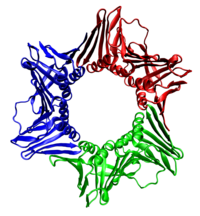
Photo from wikipedia
Artificial antigen-presenting cells (aAPCs) constructed by integrating T cell activation ligands on biocompatible materials hold great potential in tumor immunotherapy. However, it remains challenging to develop aAPCs, which could mimic… Click to show full abstract
Artificial antigen-presenting cells (aAPCs) constructed by integrating T cell activation ligands on biocompatible materials hold great potential in tumor immunotherapy. However, it remains challenging to develop aAPCs, which could mimic the characteristics of natural APCs, thereby realizing antigen-specific T cells activation in vivo. Here, we report the first effort to construct natural lymphocyte-based homologous targeting aAPCs (LC-aAPCs) with lipid-DNA-mediated noninvasive live cell surface engineering. Through a predesigned bottom-up self-assembly path, we achieved natural-APC-mimicking distribution of T cell activation ligands on LC-aAPCs, which would enable the optimized T cell activation. Moreover, the lipid-DNA-mediated self-assembly occurring on lipid bilayers would not affect the functions of homing receptors expressed on lymphocyte. Therefore, such LC-aAPCs could actively migrate to peripheral lymphatic organs and then effectively activate antigen-specific T cells. Combined with an immune checkpoint inhibitor, such LC-aAPCs could effectively inhibit the growth of different tumor models. Thus, our work provides a new design of aAPCs for in vivo applications in tumor immunotherapy, and the lipid-DNA-mediated noninvasive live cell surface engineering would be a powerful tool for designing cell-based therapeutics.
Journal Title: Journal of the American Chemical Society
Year Published: 2022
Link to full text (if available)
Share on Social Media: Sign Up to like & get
recommendations!